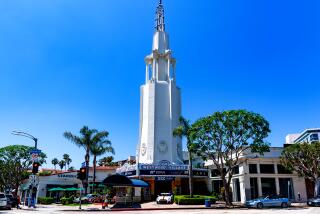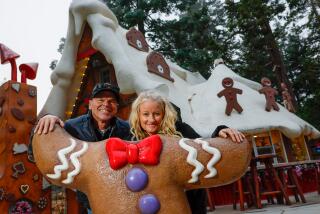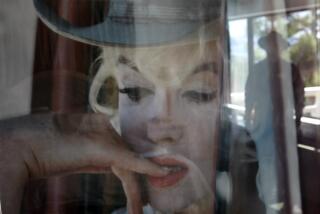Hotsy Totsy Boy Is Top Draw at Welk Village
ESCONDIDO — Harold Squier is a retired businessman who did quite well in the overseas moving and storage business and who today owns a 1,100-acre ranch in Oklahoma, where hired hands work 400 head of cattle.
But perhaps his most noteworthy business venture was in starting Squier Oaks, a humble, river-bottom mobile home park with a small restaurant, four-room motel and a nine-hole, par-three golf course.
You’ve surely never heard of Squier Oaks because the name was changed in 1964 when he sold it to a real nice fella from North Dakota--an accordionist who said he was never good enough to play in someone else’s band so he started his own.
Squier’s little park with 106 spaces has become a community of 453 families in not-so-mobile homes, some costing upward of $90,000, surrounded by such amenities as 36 holes of golf, a restaurant and bakery, a dinner theater, a 96-room motel, a Scripps Clinic satellite office, an attorney’s office, pricey time-share resort condominiums, tennis courts, and fancy boutiques, galleries and gift shops selling, among other things, souvenirs reflecting on the life and times of the accordionist from a wheat farm.
Harold Squier himself calls this the place that Lawrence Welk built.
Libbie Salat, from Cedar Rapids, Iowa, and her sister, Evelyn Cooper, from Tucson, Ariz., are browsing through one of the gift shops at Lawrence Welk Resort Village, picking up this and that and looking for just the right souvenir to take home.
Salat displays the same kind of awe and excitement as a little girl on her first visit to Disneyland with her eyes peeled for Mickey Mouse.
“Maybe he’s here!” she says of Welk, her eyebrows raised. Indeed, it’s every tourist’s hope that Lawrence Welk himself will walk in at that very moment, play a piece on the accordion he keeps here, or take a woman into his arm for a few dance steps.
“Saturday night was Lawrence Welk night in our home,” she says, explaining her anonymous affair with Welk. “Oh, I do hope he’s here!”
Such unbridled optimism sets the mood at the Lawrence Welk Restaurant, where Welk may, at any moment, present himself to his fans.
“For the customers who come in here, it’s an event,” said Jan Maxwell, who has been a waitress at the Lawrence Welk Restaurant for seven years but is still considered one of the new people on the work crew.
“Everyone who walks in hopes to see Lawrence. They ask, ‘Do you think he’ll be in today?’ They’re so hopeful. And, when he is here, they get so excited you’d think Elvis Presley just walked in. He goes from table to table and is so gracious. He’ll point out the window to his home up on the hill and people get the biggest kick.”
In fact, Welk and his wife, Fern, live in “Champagne Towers,” a 119-unit apartment building they own in Santa Monica, and they visit the Escondido resort perhaps one weekend a month. But even if Welk isn’t here, few tourists seem to leave disappointed. After all, in how many restaurants can you sit beneath crystal balls hung from the ceiling to look like so many champagne bubbles, or sit beneath hundreds of little ceiling lights arranged in concentric circles like grooves in a huge record album, or look out the window onto a golf course where a champagne glass-shaped fountain serves as a centerpiece of a water hazard?
This resort may be home to 453 mobile-home families but, more importantly, it’s a shrine to Lawrence Welk, one-time leader of the Hotsy Totsy Boys who, thanks to an unprecedented 27 years of exposure on national television, became the Musical Maestro for Middle America, his arrangements sounding so light and bubbly that his musicians were proclaimed “champagne musicmakers.”
Welk’s Slavic folk-dance tunes, Western ballads and semi-classical pieces were often knocked as square or cornball but, by golly, they--along with his troupe of dancers and singers--were hugely popular, showcased weekly on ABC-TV and later through syndication. Welk himself prefers Dixieland tunes, but for the show he said he would play whatever pleased the masses, and he found a formula that kept him on the air longer than any other musician.
Welk often used his program to give “my little place in Escondido” a national showcase and, sure enough, the resort village of about 750 full-time residents has evolved into a favorite destination for vacationers and tour buses filled with senior citizens. While a good number of visitors at the resort are area residents who enjoy the village for shopping and lunch or dinner, resort officials say a majority of visitors are from outside San Diego County and a disproportionate number of tourists come from such states as Wisconsin, Minnesota, Illinois and Michigan, where Welk’s TV show received some of its best ratings.
Old-timers here recall with chuckles how, after Welk would plug his resort community or, better yet, actually film a segment or an entire show from the local resort, the place would be hopping during the next few days with tourists hoping to catch a glimpse of Welk & Co. Never mind that the show may have been filmed months earlier and everyone had long since left for Santa Monica, home base for Welk’s Teleklew Productions Inc. (“Tele” as in vision and “klew” as in Welk spelled backwards.)
Even though the weekly Lawrence Welk Show went off the air in 1982, the resort continues to draw more people every year; last year, more than half a million tourists spent a few hours--and a few dollars--here, said Bob Dias, general manager of the resort. More than 150,000 people--for all intents and purposes, a Welk fan club--are on the resort’s free mailing list, which includes a Welk newsletter three times a year.
Visitors at the resort can pose alongside not one but two bronze life-size statues of Welk, walk on solid brass musical notes set in the concrete sidewalks, and visit--for free--the Welk museum in the lobby of the 319-seat Lawrence Welk Village Theater. Displayed inside the museum are such Welk memorabilia as gold records, a radio studio mock-up, photographs of Welk’s musical family and pictures of Welk as a budding accordionist working the farm communities of the Midwest. Unabashed fans can walk onto a mock bandstand and pose alongside a life-size wooden cutout of the conductor--and then see themselves live, on a television monitor, giving the fantasy illusion of sharing the TV stage with Lawrence himself. Take a picture and the folks back home will just die!
Busloads of group-sale theatergoers are attracted to matinee and evening performances of such Welk-rated shows as “Tribute” (Jack Klugman), “Same Time Next Year” (Jo Anne Worley), “No, No, Nanette,” “The Pirates of Penzance,” “Barefoot in the Park,” “My Fair Lady” and the show that concludes tonight, “I Know I’ve Heard That Song Before . . . 1985” starring one of Welk’s most popular singers, Guy Hovis.
Older golfers are attracted here by Welk’s two manicured, abbreviated courses (one, an 18-hole par-three course laid out under a blanket of oak trees; the other, a more challenging 18-hole mix of par threes and fours that plays up and down some gentle hillsides).
The latest addition at Lawrence Welk Resort Village is his time-share “resort villas”--two-bedroom, two-bath condominiums that opened one year ago. The first 64 of 286 units are completed and said to be selling well; a week’s share of a condominium costs $7,500 to more than $10,000, depending on location and the week of the year for which the share is purchased.
Welk, who will turn 83 in March, maintains a customized, but not ostentatious, mobile home at the top of the mobile home park, on a site that commands a view worthy of, say, the owner of the place. Welk also has begun developing 2.5-acre hilltop lots overlooking the resort with views of the Pacific Ocean, 14 miles away, and he says he’ll build his own retirement home there.
For now, Welk apologizes for not spending more time at the resort (“I’d like to go down there much more often, but I just can’t seem to find the time.”). He says he enjoys the resort because of its climate, but he says he also enjoys the attention he gets from his fans. “I don’t mind signing autographs; I like people and I really want to always please them,” he said.
He has trouble recalling the details of how he stumbled across the place back in 1964, and defers to Ted Lennon, his executive vice president and uncle of the Lennon Sisters.
Lennon tells this story:
“We had done a study on what we might do for Lawrence’s personal tax shelters and someone suggested that he get into citrus orchards, so we drove down to North (San Diego) County.”
About the same time, Lennon and Burt Carter, a friend and business associate of Welk’s, noticed a small for-sale advertisement in the Wall Street Journal for a mobile home park and nine-hole golf course a few miles north of Escondido. They wanted to check it out without pointing it out to Welk.
On April 1, the three drove to the area with a real estate agent. The party drove past Squier Oaks, and Lennon and Carter gave it a quick once-over; a few minutes later, Welk--who had noticed a for-sale sign in front of the place and who at that point was riding separately with the real estate agent--asked to be let off so he could continue on his own with Lennon and Carter.
“He came back to our car and said, ‘Did you see that little golf course?’ So, we went back there for lunch,” Lennon said.
Harold Squier was not around that day, but the restaurant manager called Squier’s wife, Evelyn, to say she ought to come down and say hello to Lawrence Welk. Evelyn, noting that it was, after all, April Fool’s Day, came down to the restaurant “in her robe and curlers. And Lawrence opened the door for her,” Lennon said.
Evelyn flatly but good-naturedly denies the humorous anecdote. “Nobody at that park would ever walk into that restaurant with curlers and a robe on,” she says. “It’s a great story but it’s not true.”
Nonetheless, she made Welk’s acquaintance, one thing led to another, and Welk bought the 6-month-old mobile home park and golf course a few weeks later.
“I’ve never dealt with a finer man,” Harold said. “There was no bargaining, no chiseling. He paid my price and that was that. And I’m proud of what Lawrence has done there. Only he could have done it.”
Within two years, Welk expanded the park to about 200 mobile home spaces; within four years he built a restaurant and motel, and in 1970 he added nine golf holes. In the late ‘70s, 253 mobile home spaces were added and filled with new-generation mobile homes, giving the park a split architectural personality. About the same time, 40 motel units were added, the restaurant was expanded to its current seating capacity of 600, and construction of the commercial complex was begun. In 1980, Welk dedicated the theater-museum, and last year marked the occupancy of the time-share villas and completion of the new, 18-hole golf course.
A $450,000 clubhouse is under construction, and Welk executives talk of adding still more retail businesses (which will provide second-story living quarters for the theater’s road actors), a new management center, expansion of the motel by 66 rooms, the eventual completion of the condominiums and development of the hilltop view lots.
Many of the 200-plus employees of the resort are residents there as well; retired executives now keep busy as mere hourly employees of the resort. W.D. Cochran, for instance, is a retired pharmaceutical representative and investor who now drives a tram around the village and makes wisecracks to his tram passengers like, “Ladies, it gets windy up here on the hill, and the driver won’t stop for wigs.”
Dias, the general manager, said, “I couldn’t find better people to work for me than the ones who live here.”
It is a trouble-free resort to operate, Dias said: “There is no vandalism, no bad checks, no bad credit cards. Some resorts position themselves for upscale customers or for conventions. We don’t because we don’t have to. Most resorts don’t have our kind of entertainment base, and the kind of stable work force that we have, where even the full-time busboys get profit-sharing. This is a resort for Middle America.”
The resort’s evolution from a quiet mobile home park to a 1,000-acre tourist hangout is a source of both excitement and consternation to residents of the park, who live behind a security-guarded gate to keep tour buses and other tourists from running the residents’ golf carts off the road.
Dorothy Walker and her husband, Herm, moved to the park 20 years ago and remember paying $50 a month in rent (compared to their $260-a-month rent now).
“It’s a good feeling, knowing that he owns the place,” Walker said. “That makes it more interesting. And even though he’s a drawing card and it brings a lot of people in, we don’t mind. Actually, it’s nice having the little markets and deli here. It saves us having to go into town.”
The park’s senior residents are 88-year-old Alec Morris and his wife, Yvette, who were the first to move into the park, back in Squier’s day.
“We talk about the good old days, when it was very, very friendly and everybody knew everybody,” Morris said. “Now we’ve lost our identity to some extent because the place is so large. But you’ve got to make room for progress. It’s brought a lot of conveniences.”
Morris has shot 20 holes-in-one on the par-three course and figures he has played golf with Welk more than 100 times. To this day, Morris plays golf three times a week.
Bill and Ruth Keister moved to the park in 1977, willing to commute more than 200 miles daily, five days a week, to his job as a music director for schools in West Covina in order to live at Welk’s. Five years later, worn down by the drive, the couple moved to Diamond Bar, cutting his drive time to a fraction.
“But we didn’t like living up there, so back we came and he began commuting again,” Ruth Keister said. Her husband retired four weeks ago and is now enjoying the good life full time.
“This place isn’t the quiet, cozy village it used to be, when everyone knew each other,” she said. “But I guess that’s progress.”
Alex Meadows is a native of London who played golf here one day three years ago, liked what he saw and bought his golf partner’s mobile home that very night.
“This place is Shangri-La,” he said, “and most of the people here would choose Lawrence over the Pope.”
More to Read
Sign up for The Wild
We’ll help you find the best places to hike, bike and run, as well as the perfect silent spots for meditation and yoga.
You may occasionally receive promotional content from the Los Angeles Times.






